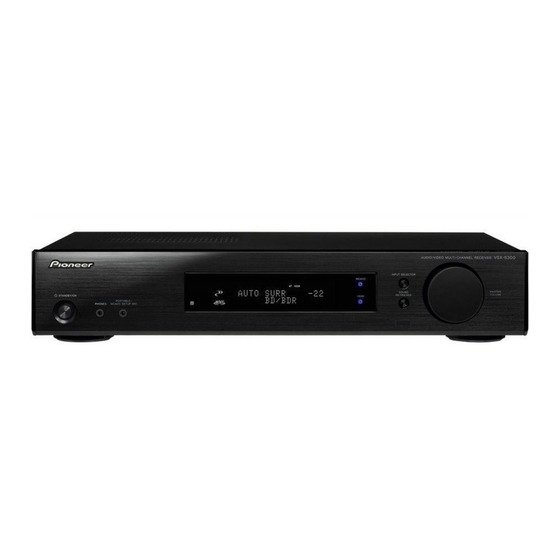Pioneer VSX-S300-k Instruções de funcionamento - Página 8
Procurar online ou descarregar pdf Instruções de funcionamento para Sistema de altifalantes Pioneer VSX-S300-k. Pioneer VSX-S300-k 36 páginas. Audio/video multi-channel receiver
Também para Pioneer VSX-S300-k: Manual de início rápido (33 páginas)

01
Controls and displays
01
9 S.RTRV
Press to restore CD quality sound to compressed audio
sources (page 24).
10 Listening mode buttons
AUTO/DIRECT – Switches between Auto surround mode
(page 22) and Stream Direct playback (page 23).
ALC/STANDARD – Press for standard decoding and to
switch between the modes of 2 Pro Logic II, 2 Pro
Logic IIx, 2 Pro Logic IIz and NEO:6, and the Auto level
control stereo mode (page 22).
ADV SURR – Switches between the various surround
modes (page 23).
SOUND WING – Press to select Sound wing mode
(page 22).
11 VOL +/–
Use to set the listening volume.
12 MUTE
Mutes/unmutes the sound.
Loading the batteries
The batteries included with the unit are to check initial
operations; they may not last over a long period. We
recommend using alkaline batteries that have a longer life.
CAUTION
• Incorrect use of batteries may result in such hazards as
leakage and bursting. Observe the following precautions:
-
Never use new and old batteries together.
Insert the plus and minus sides of the batteries properly
-
according to the marks in the battery case.
Batteries with the same shape may have different
-
voltages. Do not use different batteries together.
8
En
-
When disposing of used batteries, please comply with
governmental regulations or environmental public
instruction's rules that apply in your country or area.
Do not use or store batteries in direct sunlight or other
-
excessively hot place, such as inside a car or near a
heater. This can cause batteries to leak, overheat,
explode or catch fire. It can also reduce the life or
performance of batteries.
Operating range of remote control
The remote control may not work properly if:
• There are obstacles between the remote control and the
receiver's remote sensor.
• Direct sunlight or fluorescent light is shining onto the
remote sensor.
• The receiver is located near a device that is emitting
infrared rays.
• The receiver is operated simultaneously with another
infrared remote control unit.
30°
30°
7 m
